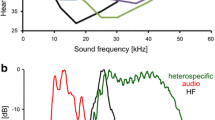Abstract
We analyzed the response of the vibration sensitive lyriform organ on the metatarsus of female spiders (Cupiennius salei) to dummies of male courtship vibrations. One of the two representative slits studied is sharply tuned to 500 Hz. Only the other slit is sensitive enough at lower frequencies to represent the parameters contained in the behaviourally effective dummies:
-
1.
Amplitude. The physiological threshold is similar to the behavioural threshold. The stimulus acceleration amplitudes leading to a good synchronization between response and temporal stimulus pattern coincide with those effectively eliciting a behavioural response. The most frequent spike intervals remain nearly constant in this range. At acceleration amplitudes above the natural range, syllable and pause durations are misrepresented by the receptor response.
-
2.
Frequency. Varying the carrier frequency between 35–500 Hz changes the most frequent spike intervals. Interval histograms resulting from behaviourally effective stimuli (50–200 Hz), however, are similr for carrier frequencies differing by a factor of 2.
-
3.
Temporal pattern. Response duration reflects the temporal parameters of the stimulus. The most frequent spike interval only changes with temporal stimulus characteristics far off the natural range. The number of spikes during a syllable decreases in ongoing stimulus series. The quality of copying the temporal stimulus pattern remains unchanged, however.
Similar content being viewed by others
Abbreviations
- AA:
-
acceleration amplitude
- CF:
-
carrier frequency
- DC:
-
duty cycle
- MO:
-
metatarsal lyriform organ
- ns :
-
number of spikes elicited during one syllable
- PD:
-
pause duration
- SC:
-
synchronization coefficient
- SD:
-
syllable duration
- T:
-
sinewave period of stimulus
References
Barth FG (1993) Sensory guidance in spider precopulatory behaviour. Comp Biochem Physiol 104A:717–733
Barth FG, Geethabali (1982) Spider vibration receptors. Threshold curves of individual slits in the metatarsal lyriform organ. J Comp Physiol 148:175–185
Barth FG, Schmitt A (1991) Species recognition and species isolation in wandering spiders (Cupiennius spp., Ctenidae). Behav Ecol Sociobiol 29:333–339
Barth FG, Seyfarth EA, Bleckmann H, Schüch W (1988) Spiders of the genus Cupiennius Simon 1891 (Araneae, Ctenidae). I. Range distribution, dwelling plants, and climatic characteristics of the habitats. Oecologia 77:187–193
Baurecht D, Barth FG (1992) Vibratory communication in spiders. I. Representation of male courtship signals by female vibration receptor. J Comp Physiol A 171:231–243
Baurecht D, Deutsch WA, Noll A, Barth FG (1989) Digital signal processing system: recording, analysis and replay in bioacoustical experiments. In: Elsner N, Singer W (eds) Dynamics and plasticity in neuronal systems. G. Thieme, Stuttgart New York, p 141
Lachmuth U, Grasshoff M, Barth FG (1984) Taxonomische Revision der Gattung Cupiennius Simon 1891 (Arachnida: Araneae). Senckenbergiana Biol 65:329–372
Rovner JS, Barth FG (1981) Vibratory communication through living plants by a tropical wandering spider. Science 214:464–466
Schüch W, Barth FG (1985) Temporal patterns in the vibratory courtship signals of the wandering spider Cupiennius salei Keys. Behav Ecol Sociobiol 16:263–271
Schüch W, Barth FG (1990) Vibratory communication in a spider: female responses to synthetic male vibrations. J Comp Physiol A 166:817–826
Schildberger K (1984) Temporal selectivity of identified auditory neurons in the cricket brain. J Comp Physiol A 155:171–185
Author information
Authors and Affiliations
Rights and permissions
About this article
Cite this article
Baurecht, D., Barth, F.G. Vibratory communication in spiders. J Comp Physiol A 173, 309–319 (1993). https://doi.org/10.1007/BF00212695
Accepted:
Issue Date:
DOI: https://doi.org/10.1007/BF00212695



